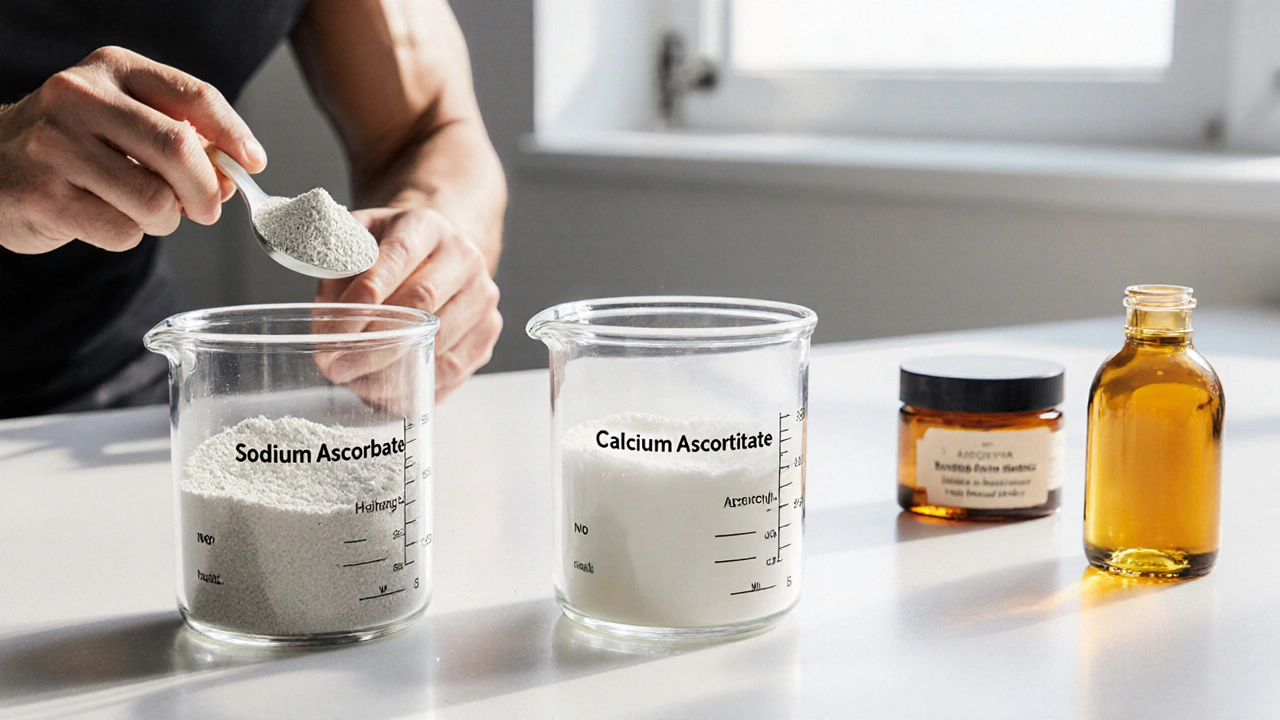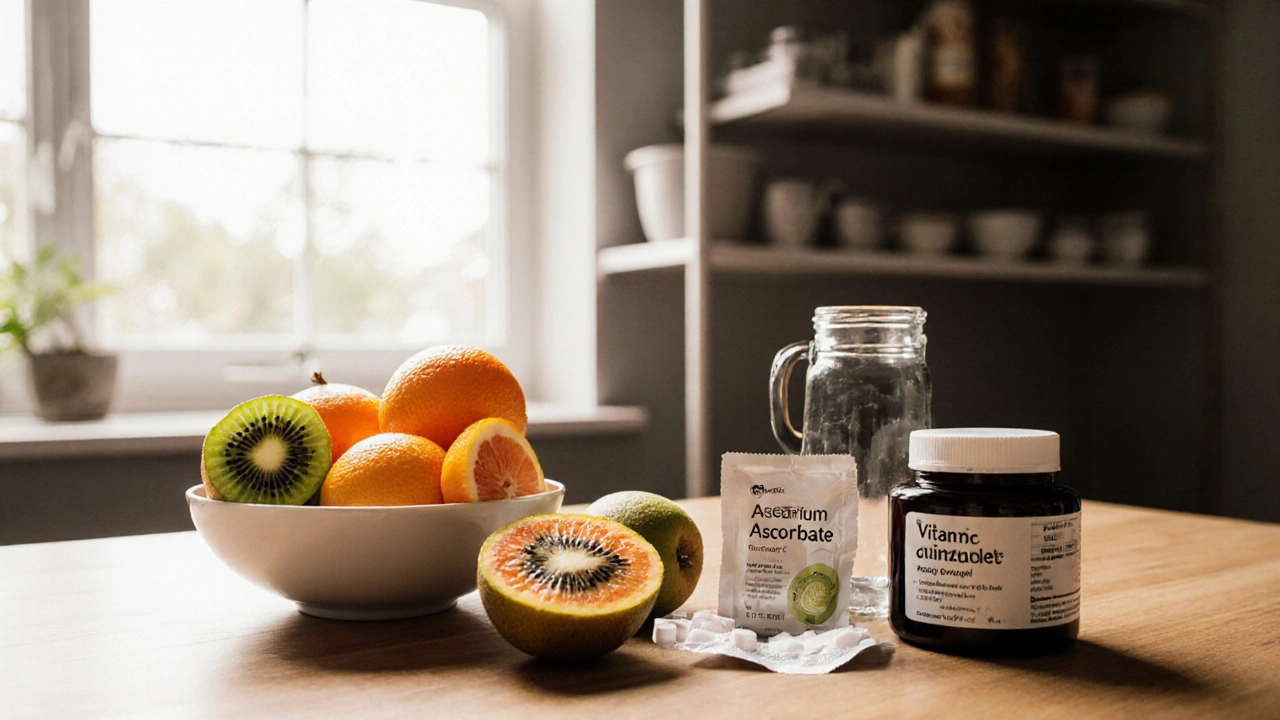Ascorbic Acid vs Alternatives: Sodium Ascorbate, Calcium Ascorbate, Ascorbyl Palmitate
 Oct, 5 2025
Oct, 5 2025
Quick Takeaways
- Ascorbic Acid is the most common vitamin C supplement but can be harsh on the stomach.
- Sodium Ascorbate and Calcium Ascorbate are buffered forms that reduce acidity while keeping high bioavailability.
- Ascorbyl Palmitate is a fat‑soluble ester useful for skin‑care and food preservation.
- Erythorbic Acid provides antioxidant power without vitamin C activity, ideal for industrial use.
- Choosing the right form depends on cost, tolerance, intended use (oral supplement, topical, or food), and dosage needs.
When people talk about vitamin C, they usually mean Ascorbic Acid the pure, water‑soluble form of vitamin C that was first isolated in 1932. It’s cheap, effective, and widely available in tablets, powders, and gummies. But if you’ve ever felt a tummy‑ache after a high dose, you’re not alone. That’s why many turn to buffered or esterified alternatives that promise the same health boost with fewer side effects.
What is Ascorbic Acid?
ascorbic acid is an essential nutrient that acts as a powerful antioxidant, helps collagen synthesis, and supports immune function. Chemically, it’s a six‑carbon lactone with the formula C6H8O6. In the body, it donates electrons to neutralize free radicals, which protects cells from oxidative damage. The recommended daily allowance for most adults is 75‑90mg, but therapeutic protocols often use 500mg to 2g per day.
While the molecule is highly effective, its low pH (around 2.5) can irritate the gastric lining, especially when taken on an empty stomach. This is where alternatives step in, offering similar antioxidant power with a gentler profile.
Why Look at Alternatives?
There are three main reasons people explore other forms of vitamin C:
- Digestive comfort: Buffered salts raise the pH, reducing acidity.
- Targeted application: Fat‑soluble esters can be mixed into creams or oily foods.
- Specialized needs: Some industries need a non‑nutrient antioxidant or a form with slower release.
Understanding the trade‑offs helps you pick a version that aligns with your health goals, budget, and lifestyle.

Major Alternatives Explained
Sodium Ascorbate a buffered salt of ascorbic acid that neutralizes stomach acidity while preserving 100% of vitamin C activity is popular among athletes and people with sensitive stomachs. It typically costs about 15‑20% more than plain ascorbic acid but offers a smoother digestion experience.
Calcium Ascorbate another buffered form that supplies both vitamin C and calcium, useful for bone health support has a slightly higher pH (around 7) and provides about 10% of the calcium content found in dairy.
Ascorbyl Palmitate an esterified version where ascorbic acid is bonded to palmitic acid, making it fat‑soluble is favored in skin‑care formulas and food preservation because it dissolves in oils and spreads evenly.
Erythorbic Acid a synthetic antioxidant that mimics vitamin C’s reducing power but does not fulfill nutritional vitamin C requirements is used mainly in processed foods and cosmetics to prevent oxidation without adding vitamin activity.
Natural Vitamin C (Citrus Fruit) the whole‑food source of ascorbic acid, containing flavonoids and bioflavonoids that aid absorption remains the gold standard for those who prefer food‑based nutrition. Fresh oranges, kiwis, and guavas typically deliver 50‑100mg per serving.
Side‑by‑Side Comparison
| Form | Bioavailability* | Typical pH (water) | Cost (USD/g) | Common Uses | Typical Dosage |
|---|---|---|---|---|---|
| Ascorbic Acid | ≈ 100% | 2.5-3.0 | 0.02 | Oral tablets, powders | 500mg-2g |
| Sodium Ascorbate | ≈ 95% | 5-6 | 0.03 | Sports nutrition, buffered supplements | 500mg-1g |
| Calcium Ascorbate | ≈ 90% | 7-8 | 0.035 | Bone‑support formulas, elderly care | 500mg-1g |
| Ascorbyl Palmitate | ≈ 70% (fat‑soluble) | ~7 (in oil) | 0.05 | Topical creams, food preservation | 100mg‑500mg (topical) |
| Erythorbic Acid | Not a vitamin source | 4-5 | 0.04 | Processed foods, cosmetics | Variable |
| Natural Citrus Fruit | ≈ 85% (plus flavonoids) | ~3 | 0.10 (per 100g fruit) | Whole‑food nutrition | 1‑2 fruits daily |
*Bioavailability figures are based on peer‑reviewed absorption studies published between 2018‑2023.

How to Choose the Right Form
Use the following decision flow to match your needs with the best vitamin C option:
- Do you experience stomach discomfort with regular tablets? If yes, try Sodium Ascorbate or Calcium Ascorbate.
- Is your goal skin health or food preservation? Ascorbyl Palmitate is the logical pick because it mixes well with oils.
- Do you need extra minerals? Calcium Ascorbate adds a modest calcium boost.
- Are you looking for a natural, whole‑food source? Fresh citrus or kiwi offers additional phytonutrients that buffered salts lack.
- Is cost the primary driver? Plain Ascorbic Acid remains the cheapest per gram.
Remember that dosage matters more than form for most health outcomes. Whether you choose a buffered salt or pure acid, staying within a safe upper limit (2g per day for adults) avoids potential side effects like kidney stones.
Practical Tips & Common Pitfalls
- Store in a cool, dark place. All vitamin C forms degrade when exposed to light and heat.
- Mix powders with a small amount of juice or water to improve absorption.
- Don’t combine high‑dose vitamin C with iron supplements without medical advice; the increased acidity can affect iron absorption.
- If you’re using Ascorbyl Palmitate in skin‑care, look for products with 5‑10% concentration; higher levels can cause irritation.
- Check labels for “added sugars” in gummy vitamins-those can offset the health benefits.
Frequently Asked Questions
Is sodium ascorbate safer for the stomach than regular vitamin C?
Yes. Sodium Ascorbate is a buffered form with a higher pH, so it causes less irritation when taken on an empty stomach. Most users report fewer heartburn symptoms compared to pure Ascorbic Acid.
Can I replace all my vitamin C supplements with citrus fruit?
Whole fruit provides vitamin C plus flavonoids that aid absorption, but you’d need to eat several servings daily to match high‑dose therapeutic levels. For most people, a mix of food and a low‑dose supplement works best.
Does ascorbyl palmitate work the same way as regular vitamin C?
It acts as an antioxidant, but because it’s fat‑soluble it’s absorbed differently and doesn’t contribute to the body’s vitamin C pool as efficiently. It’s great for topical creams and food preservation, less so for boosting systemic vitamin C levels.
What is the upper safe limit for vitamin C intake?
The Institute of Medicine sets the tolerable upper intake level for adults at 2grams per day. Exceeding this can increase the risk of kidney stones and gastrointestinal upset.
Is erythorbic acid a good substitute for vitamin C?
Erythorbic Acid provides antioxidant protection in foods but does not fulfill the nutritional role of vitamin C. It’s useful for manufacturers, not for people looking to improve health.

Erica Ardali
October 5, 2025 AT 18:43When one contemplates the alchemy of vitamin C, the purest essence whispers of ancient chemistry and modern convenience. Ascorbic Acid, that austere guardian of health, holds its throne atop the supplement aisle, yet its acidity can thunder through the stomach like a tempest. The buffered kin-sodium and calcium ascorbates-act as gentle custodians, soothing the gut while preserving the vital spark of antioxidant power. In the grand theater of nutrition, each form plays its part, demanding reverence from those who seek balance.
Justyne Walsh
October 11, 2025 AT 02:30The moral high ground of supplement choice has become a battlefield, and here we stand, armed with sarcasm. If you adore acid reflux, keep clutching your plain Ascorbic Acid like a trophy of suffering.
Mimi Saki
October 16, 2025 AT 10:16Hey, you’re not alone on the stomach‑ache trek-lots of folks feel that burn, but the buffered salts can be a game‑changer! 😊 Keep it gentle and your gut will thank you.
Subramaniam Sankaranarayanan
October 21, 2025 AT 18:03The chemistry is straightforward: ascorbic acid donates electrons, neutralizing free radicals, while its buffered counterparts raise the pH, reducing gastric irritation. Sodium ascorbate adds a sodium ion, calcium ascorbate contributes calcium, and ascorbyl palmitate attaches a fatty chain for lipophilic applications. Bioavailability remains high across the board, albeit with slight variations due to solubility differences. For anyone calibrating dosage, the choice hinges on the intended delivery matrix.
Kylie Holmes
October 27, 2025 AT 01:50Boost your routine with the buffered versions if you’re hitting the gym hard-your stomach will thank you! Let’s crush those goals without the burn.
Jennifer Wees-Schkade
November 1, 2025 AT 09:36From a formulation standpoint, sodium ascorbate offers a near‑neutral pH, making it ideal for athletes who need rapid absorption without gastric distress. Calcium ascorbate doubles as a mineral supplement, supporting bone health alongside antioxidant activity. When prescribing, consider the patient’s calcium intake and any sodium restrictions, and adjust the dosage accordingly. This targeted approach maximizes efficacy while minimizing side effects.
Fr. Chuck Bradley
November 6, 2025 AT 17:23Alas, the drama of choosing vitamin C rivals a Shakespearean tragedy-full of sighs and lamentations over acidity.
Patrick Rauls
November 12, 2025 AT 01:10Yo, if you’re feeling the burn, just switch to sodium ascorbate – it’s like chillin’ with a soda but for your gut :) no more ouchies.
Asia Lindsay
November 17, 2025 AT 08:56Team encouragement here: mixing your vitamin C powder with a splash of orange juice can make it taste better and aid absorption! 👍 Keep that positivity flowing.
Angela Marie Hessenius
November 22, 2025 AT 16:43When we examine the cultural tapestry of supplement use, we find that each individual’s choice of vitamin C form is not merely a biochemical decision but a narrative woven from personal history, socioeconomic status, and regional dietary customs. In North America, the accessibility of bulk ascorbic acid reflects a market driven by cost‑effectiveness, where consumers prioritize value over nuanced pharmacokinetic considerations. Conversely, in parts of Europe, the predilection for buffered salts can be traced to a legacy of gastrointestinal research that emphasized patient comfort and compliance. The Indian subcontinent, with its rich tradition of Ayurvedic practices, often incorporates whole‑food sources of vitamin C, such as amla, alongside modern supplements, demonstrating a syncretic approach to health. Meanwhile, the burgeoning wellness community in Australia espouses the use of ascorbyl palmitate in topical formulations, highlighting a trend where antioxidant stability in lipid matrices becomes a cornerstone of skincare regimens. Each of these geographic patterns underscores a broader sociocultural dialogue where scientific evidence interacts with local beliefs. Moreover, age demographics play a pivotal role: elderly populations tend toward calcium ascorbate, appreciating the supplemental calcium for bone density, while younger athletes gravitate to sodium ascorbate for its rapid absorption and minimal gastric upset. The intersection of gender and supplement preference also reveals intriguing trends; women often opt for natural citrus sources, valuing the additional flavonoids that synergize with vitamin C’s antioxidant network. The economics of supplement production cannot be ignored either-manufacturers calibrate pH buffers and filler agents to achieve a balance between shelf stability and consumer price points, thereby influencing market availability. Regulatory environments shape this landscape further; the FDA’s stringent labeling requirements ensure that claims about bioavailability are substantiated, whereas the European Food Safety Authority imposes limits on synthetic antioxidants like erythorbic acid, affecting their prevalence in processed foods. On a micro level, individual gut microbiota composition may dictate tolerance to acidic forms, prompting a personalized approach that leverages emerging nutrigenomic data. As we synthesize these observations, it becomes evident that the decision matrix for vitamin C supplementation extends far beyond mere biochemical efficacy. It is an amalgam of historical precedent, cultural identity, economic accessibility, and emerging scientific insight. Such complexity invites a more holistic perspective, encouraging practitioners to engage patients in conversations that honor both the science and the lived experience behind each choice.
Julian Macintyre
November 28, 2025 AT 00:30From a rigorous analytical perspective, the comparative bioavailability data merits a systematic review, given the marginal differences reported across studies. The statistical insignificance of the variance between ascorbic acid and its buffered salts suggests that patient preference may dominate prescribing practices. Nonetheless, the methodological limitations inherent in many of these trials necessitate a cautious interpretation of the results.
Patrick Hendrick
December 3, 2025 AT 08:16Choosing the right form is personal; consider tolerance, cost, and goals!!!
abhishek agarwal
December 8, 2025 AT 16:03Listen, if you’re serious about health, don’t just grab the cheapest pill-pick a form that fits your lifestyle and stick with it.